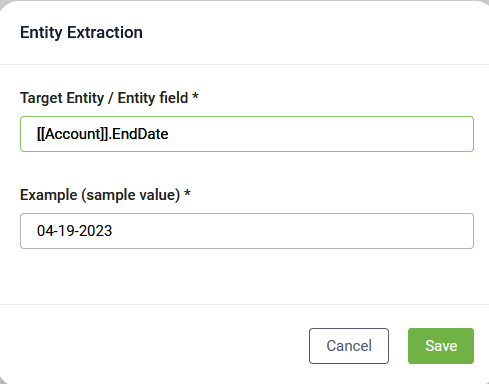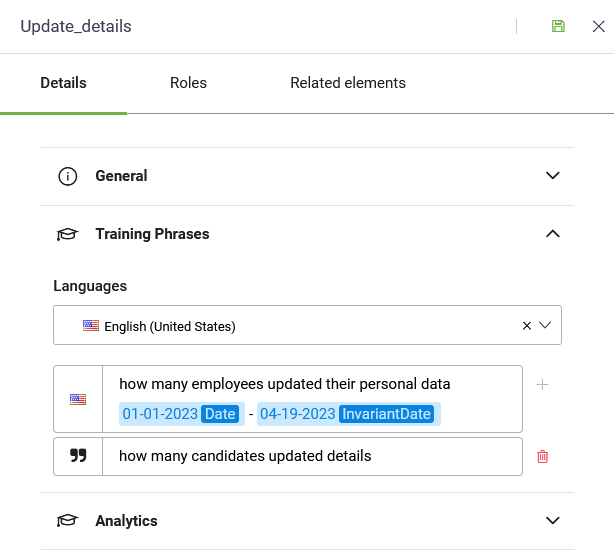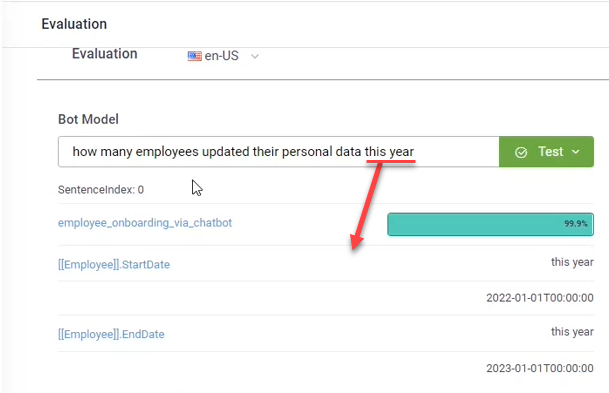Using NER with Intent Recognition
Expressions in input mapping fields are similar to flow training phrases. The difference is that they are not used for general model classification.
Users chatting with a DRUID bot can provide information in the form of expressions, not only exact-match responses.

The bot will extract the following input field from the user’s expression:
[[transfer]].Amount = 100
[[transfer]].Currency = USD
[[transfer]].RecipientName = Mary Bush
Configuring NER Parameters
The expressions in input mapping fields feature enables DRUID bot developers to configure more human-like conversations.
To configure NER parameters, use Lexicon (index your entities) and set the desired NER parameters. For more information on how to use Lexicon and index entities for NLP, see Using Lexicon.
In DRUID versions prior to 5.15, set the NER parameters in the bot details, Conversational AI section. and set up entities for NLP following the procedure described in section Using NER with index entities.
Moreover, expressions used for input mapping are configured similarly to NER training phrases. You can define the NER training phrases on each flow, in the Details tab, together with the rest of the flow’s utterances.
In DRUID version 5.0 and higher, you can also add date range in training phrases.
Provide complete training phrases with sample values for start date and end date. E.g.: "how many employees updated their personal data 01-01-2023 - 04-19-2023". In this example, the dates are sample values for the range (start date - end date).
Add target entity for the two sample values: [[Entity]].<start date field> - [[Entity]].<end date field>. To do that, select the date and click on the selection. In the pop-up that opens, click in the Target Entity / Entity field and select the desired entity field (either the entity field that stores the start date or the one that stores the end date) and click Save.
The pop-up closes and the sample values are highlighted in blue and marked with the label Date.
Example:
Save the settings.
Configuring NER in Training Phrases Example
In this example, we configure a flow for personal data update. The chat bot will ask the users to give their name and hometown.
The flow will be triggered by the utterance “Please update my personal data”.
For the bot to extract the user’s name from phrases like “My name is John Doe” and the hometown from phrases like “I live in New-York” we will make the flow settings described below.
Select the flow for personal data update and in the Details tab, click the Training Phrases section header. The section expands.
Add the utterances described in the figure below:
Where:
- All training phrases are used for classification, including NER or not.
- When NER is included within the training phrase (the second and the third phrases), the NER content contributes to the training model.
Set the required entities in the corresponding input mapping fields as shown in the figure below:
The users chatting with the bot can either respond directly with the expected value “John Doe” or “New York”, or can answer with an expression “My name is John Doe” or “I live in New York”.
To better train the chatbot for any expression the user might return into an input mapping step, you can add various training phrases on the flow. For example: “Friends call me John Doe”, “My hometown is New York”, etc. In these examples, "John Doe" is sample value for entity [[Account]].Name and "New York" is sample value for entity [[City]].
The entity extraction can be both:
- deterministic when the expected value is just a simple string, numerical or datetime expression (as in the previous example).
- nondeterministic when the expected value is an element of an indexed list of elements – in this case, an indexed entity type value.
The [[City]] entity has the “Name” field indexed and its values are trained using the DRUID entity train mechanism.
The user will be asked to choose from a list of cities the entity was indexed with.





